Gender and Victimization
VerifiedAdded on 2023/06/07
|9
|2696
|135
AI Summary
This article explores the relationship between gender and victimization, discussing theories and factors that contribute to victimization. It also examines how victimization has changed over time and the gender differences in risk of victimization.
Contribute Materials
Your contribution can guide someone’s learning journey. Share your
documents today.
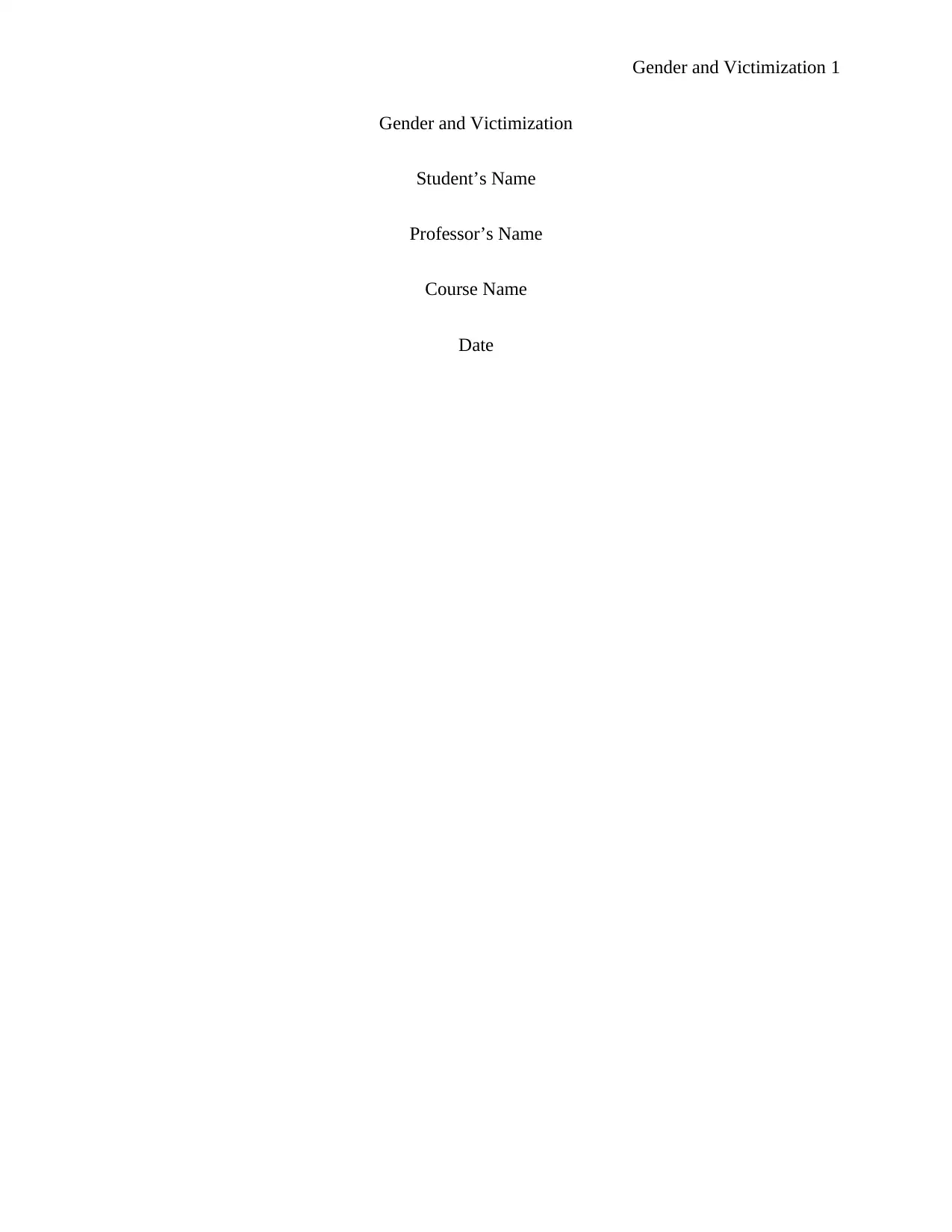
Gender and Victimization 1
Gender and Victimization
Student’s Name
Professor’s Name
Course Name
Date
Gender and Victimization
Student’s Name
Professor’s Name
Course Name
Date
Secure Best Marks with AI Grader
Need help grading? Try our AI Grader for instant feedback on your assignments.
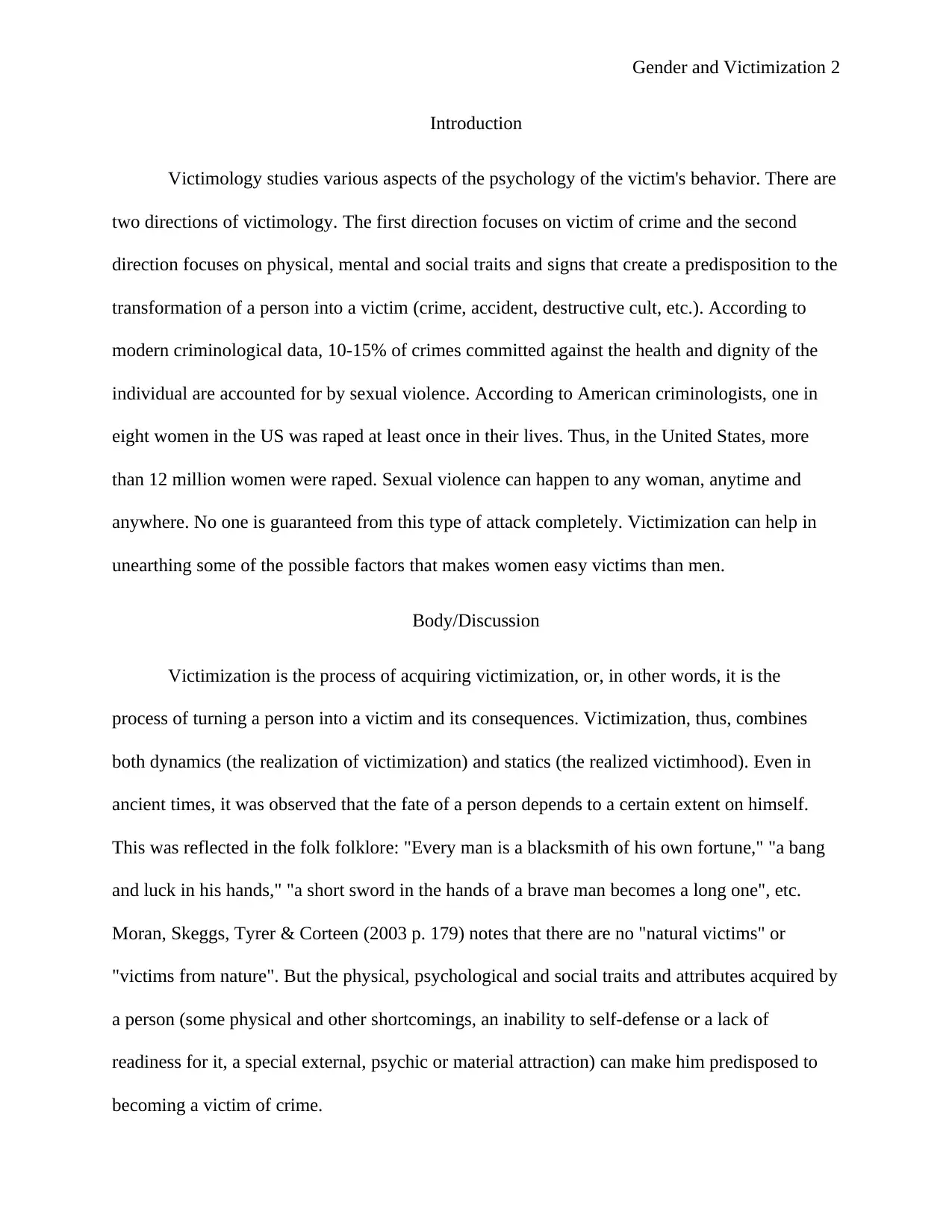
Gender and Victimization 2
Introduction
Victimology studies various aspects of the psychology of the victim's behavior. There are
two directions of victimology. The first direction focuses on victim of crime and the second
direction focuses on physical, mental and social traits and signs that create a predisposition to the
transformation of a person into a victim (crime, accident, destructive cult, etc.). According to
modern criminological data, 10-15% of crimes committed against the health and dignity of the
individual are accounted for by sexual violence. According to American criminologists, one in
eight women in the US was raped at least once in their lives. Thus, in the United States, more
than 12 million women were raped. Sexual violence can happen to any woman, anytime and
anywhere. No one is guaranteed from this type of attack completely. Victimization can help in
unearthing some of the possible factors that makes women easy victims than men.
Body/Discussion
Victimization is the process of acquiring victimization, or, in other words, it is the
process of turning a person into a victim and its consequences. Victimization, thus, combines
both dynamics (the realization of victimization) and statics (the realized victimhood). Even in
ancient times, it was observed that the fate of a person depends to a certain extent on himself.
This was reflected in the folk folklore: "Every man is a blacksmith of his own fortune," "a bang
and luck in his hands," "a short sword in the hands of a brave man becomes a long one", etc.
Moran, Skeggs, Tyrer & Corteen (2003 p. 179) notes that there are no "natural victims" or
"victims from nature". But the physical, psychological and social traits and attributes acquired by
a person (some physical and other shortcomings, an inability to self-defense or a lack of
readiness for it, a special external, psychic or material attraction) can make him predisposed to
becoming a victim of crime.
Introduction
Victimology studies various aspects of the psychology of the victim's behavior. There are
two directions of victimology. The first direction focuses on victim of crime and the second
direction focuses on physical, mental and social traits and signs that create a predisposition to the
transformation of a person into a victim (crime, accident, destructive cult, etc.). According to
modern criminological data, 10-15% of crimes committed against the health and dignity of the
individual are accounted for by sexual violence. According to American criminologists, one in
eight women in the US was raped at least once in their lives. Thus, in the United States, more
than 12 million women were raped. Sexual violence can happen to any woman, anytime and
anywhere. No one is guaranteed from this type of attack completely. Victimization can help in
unearthing some of the possible factors that makes women easy victims than men.
Body/Discussion
Victimization is the process of acquiring victimization, or, in other words, it is the
process of turning a person into a victim and its consequences. Victimization, thus, combines
both dynamics (the realization of victimization) and statics (the realized victimhood). Even in
ancient times, it was observed that the fate of a person depends to a certain extent on himself.
This was reflected in the folk folklore: "Every man is a blacksmith of his own fortune," "a bang
and luck in his hands," "a short sword in the hands of a brave man becomes a long one", etc.
Moran, Skeggs, Tyrer & Corteen (2003 p. 179) notes that there are no "natural victims" or
"victims from nature". But the physical, psychological and social traits and attributes acquired by
a person (some physical and other shortcomings, an inability to self-defense or a lack of
readiness for it, a special external, psychic or material attraction) can make him predisposed to
becoming a victim of crime.
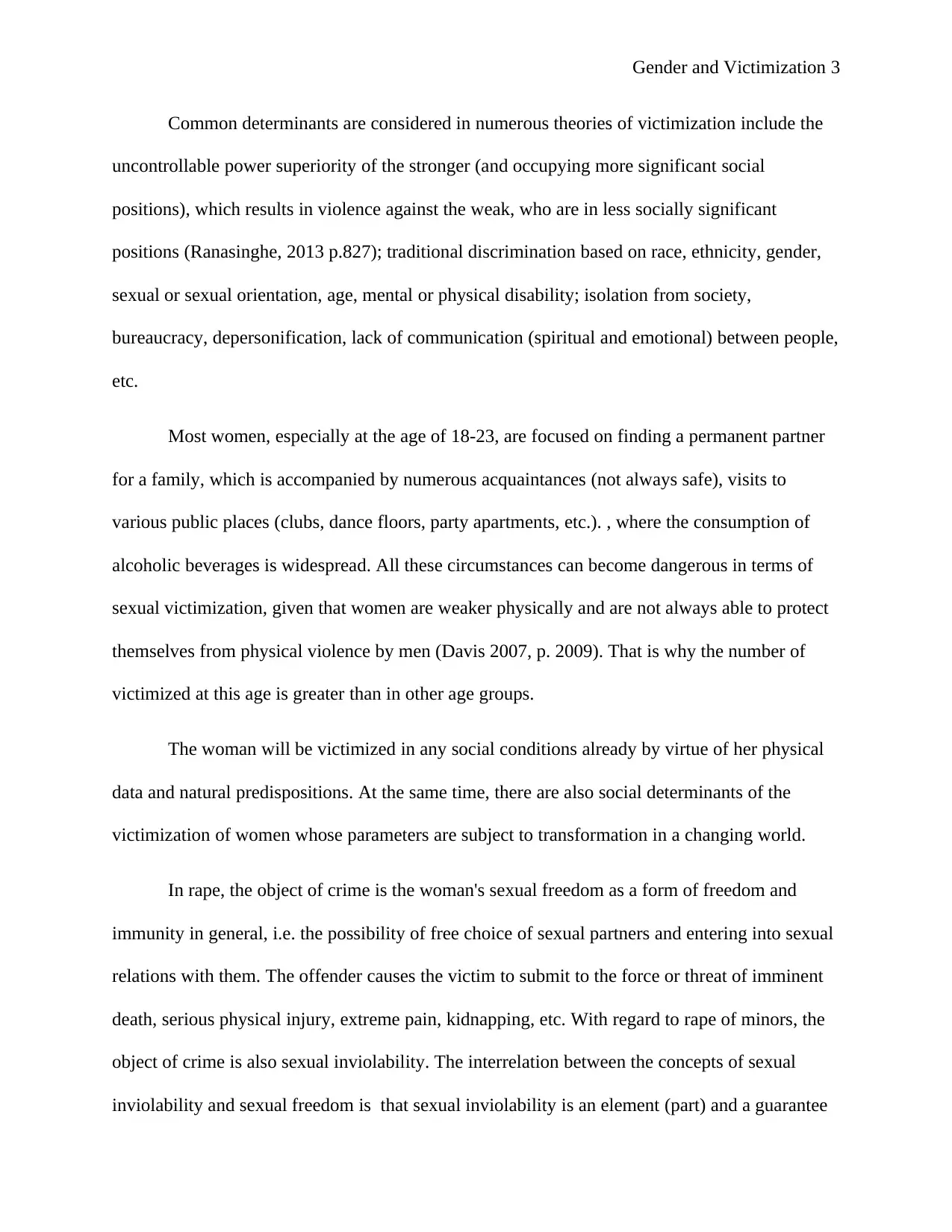
Gender and Victimization 3
Common determinants are considered in numerous theories of victimization include the
uncontrollable power superiority of the stronger (and occupying more significant social
positions), which results in violence against the weak, who are in less socially significant
positions (Ranasinghe, 2013 p.827); traditional discrimination based on race, ethnicity, gender,
sexual or sexual orientation, age, mental or physical disability; isolation from society,
bureaucracy, depersonification, lack of communication (spiritual and emotional) between people,
etc.
Most women, especially at the age of 18-23, are focused on finding a permanent partner
for a family, which is accompanied by numerous acquaintances (not always safe), visits to
various public places (clubs, dance floors, party apartments, etc.). , where the consumption of
alcoholic beverages is widespread. All these circumstances can become dangerous in terms of
sexual victimization, given that women are weaker physically and are not always able to protect
themselves from physical violence by men (Davis 2007, p. 2009). That is why the number of
victimized at this age is greater than in other age groups.
The woman will be victimized in any social conditions already by virtue of her physical
data and natural predispositions. At the same time, there are also social determinants of the
victimization of women whose parameters are subject to transformation in a changing world.
In rape, the object of crime is the woman's sexual freedom as a form of freedom and
immunity in general, i.e. the possibility of free choice of sexual partners and entering into sexual
relations with them. The offender causes the victim to submit to the force or threat of imminent
death, serious physical injury, extreme pain, kidnapping, etc. With regard to rape of minors, the
object of crime is also sexual inviolability. The interrelation between the concepts of sexual
inviolability and sexual freedom is that sexual inviolability is an element (part) and a guarantee
Common determinants are considered in numerous theories of victimization include the
uncontrollable power superiority of the stronger (and occupying more significant social
positions), which results in violence against the weak, who are in less socially significant
positions (Ranasinghe, 2013 p.827); traditional discrimination based on race, ethnicity, gender,
sexual or sexual orientation, age, mental or physical disability; isolation from society,
bureaucracy, depersonification, lack of communication (spiritual and emotional) between people,
etc.
Most women, especially at the age of 18-23, are focused on finding a permanent partner
for a family, which is accompanied by numerous acquaintances (not always safe), visits to
various public places (clubs, dance floors, party apartments, etc.). , where the consumption of
alcoholic beverages is widespread. All these circumstances can become dangerous in terms of
sexual victimization, given that women are weaker physically and are not always able to protect
themselves from physical violence by men (Davis 2007, p. 2009). That is why the number of
victimized at this age is greater than in other age groups.
The woman will be victimized in any social conditions already by virtue of her physical
data and natural predispositions. At the same time, there are also social determinants of the
victimization of women whose parameters are subject to transformation in a changing world.
In rape, the object of crime is the woman's sexual freedom as a form of freedom and
immunity in general, i.e. the possibility of free choice of sexual partners and entering into sexual
relations with them. The offender causes the victim to submit to the force or threat of imminent
death, serious physical injury, extreme pain, kidnapping, etc. With regard to rape of minors, the
object of crime is also sexual inviolability. The interrelation between the concepts of sexual
inviolability and sexual freedom is that sexual inviolability is an element (part) and a guarantee
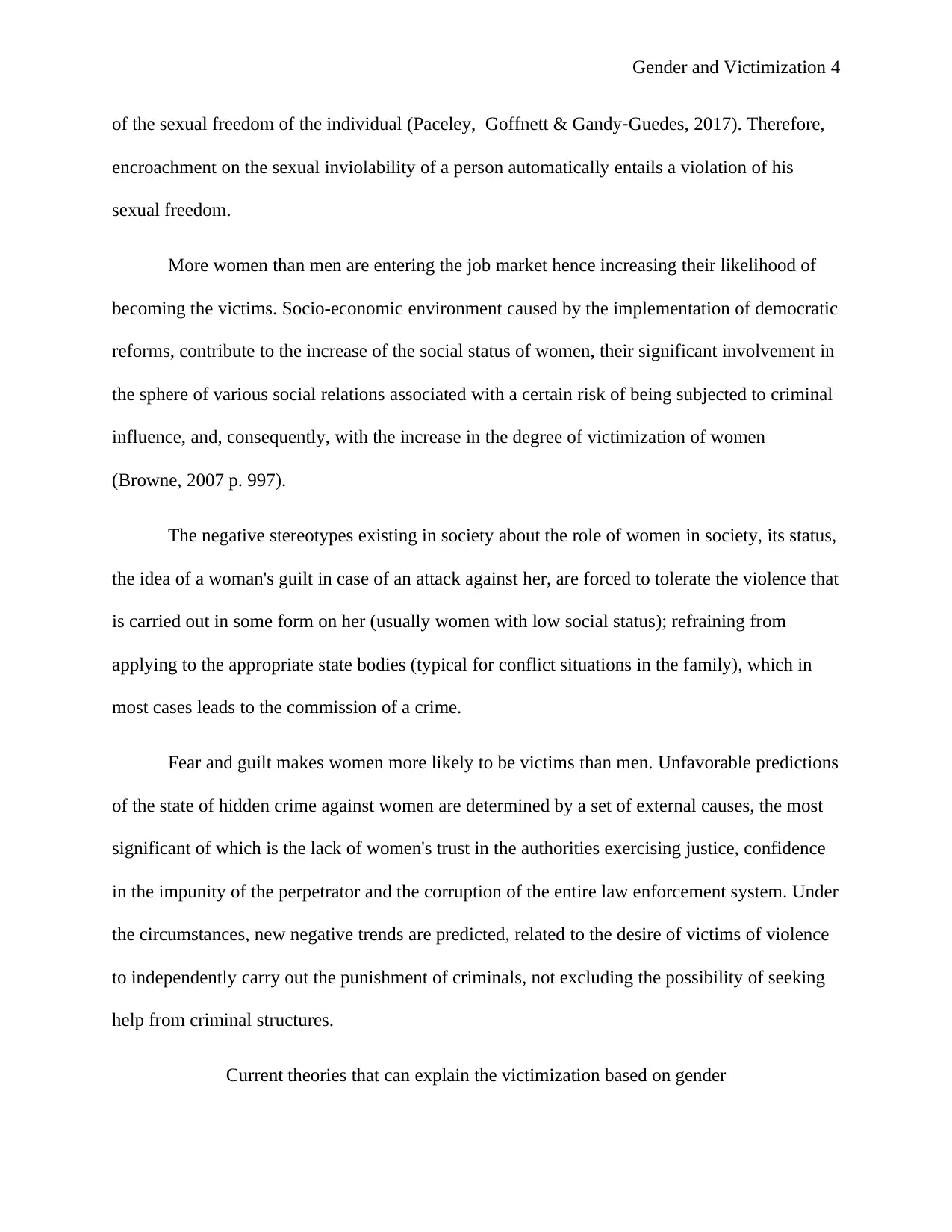
Gender and Victimization 4
of the sexual freedom of the individual (Paceley, Goffnett & Gandy‐Guedes, 2017). Therefore,
encroachment on the sexual inviolability of a person automatically entails a violation of his
sexual freedom.
More women than men are entering the job market hence increasing their likelihood of
becoming the victims. Socio-economic environment caused by the implementation of democratic
reforms, contribute to the increase of the social status of women, their significant involvement in
the sphere of various social relations associated with a certain risk of being subjected to criminal
influence, and, consequently, with the increase in the degree of victimization of women
(Browne, 2007 p. 997).
The negative stereotypes existing in society about the role of women in society, its status,
the idea of a woman's guilt in case of an attack against her, are forced to tolerate the violence that
is carried out in some form on her (usually women with low social status); refraining from
applying to the appropriate state bodies (typical for conflict situations in the family), which in
most cases leads to the commission of a crime.
Fear and guilt makes women more likely to be victims than men. Unfavorable predictions
of the state of hidden crime against women are determined by a set of external causes, the most
significant of which is the lack of women's trust in the authorities exercising justice, confidence
in the impunity of the perpetrator and the corruption of the entire law enforcement system. Under
the circumstances, new negative trends are predicted, related to the desire of victims of violence
to independently carry out the punishment of criminals, not excluding the possibility of seeking
help from criminal structures.
Current theories that can explain the victimization based on gender
of the sexual freedom of the individual (Paceley, Goffnett & Gandy‐Guedes, 2017). Therefore,
encroachment on the sexual inviolability of a person automatically entails a violation of his
sexual freedom.
More women than men are entering the job market hence increasing their likelihood of
becoming the victims. Socio-economic environment caused by the implementation of democratic
reforms, contribute to the increase of the social status of women, their significant involvement in
the sphere of various social relations associated with a certain risk of being subjected to criminal
influence, and, consequently, with the increase in the degree of victimization of women
(Browne, 2007 p. 997).
The negative stereotypes existing in society about the role of women in society, its status,
the idea of a woman's guilt in case of an attack against her, are forced to tolerate the violence that
is carried out in some form on her (usually women with low social status); refraining from
applying to the appropriate state bodies (typical for conflict situations in the family), which in
most cases leads to the commission of a crime.
Fear and guilt makes women more likely to be victims than men. Unfavorable predictions
of the state of hidden crime against women are determined by a set of external causes, the most
significant of which is the lack of women's trust in the authorities exercising justice, confidence
in the impunity of the perpetrator and the corruption of the entire law enforcement system. Under
the circumstances, new negative trends are predicted, related to the desire of victims of violence
to independently carry out the punishment of criminals, not excluding the possibility of seeking
help from criminal structures.
Current theories that can explain the victimization based on gender
Secure Best Marks with AI Grader
Need help grading? Try our AI Grader for instant feedback on your assignments.
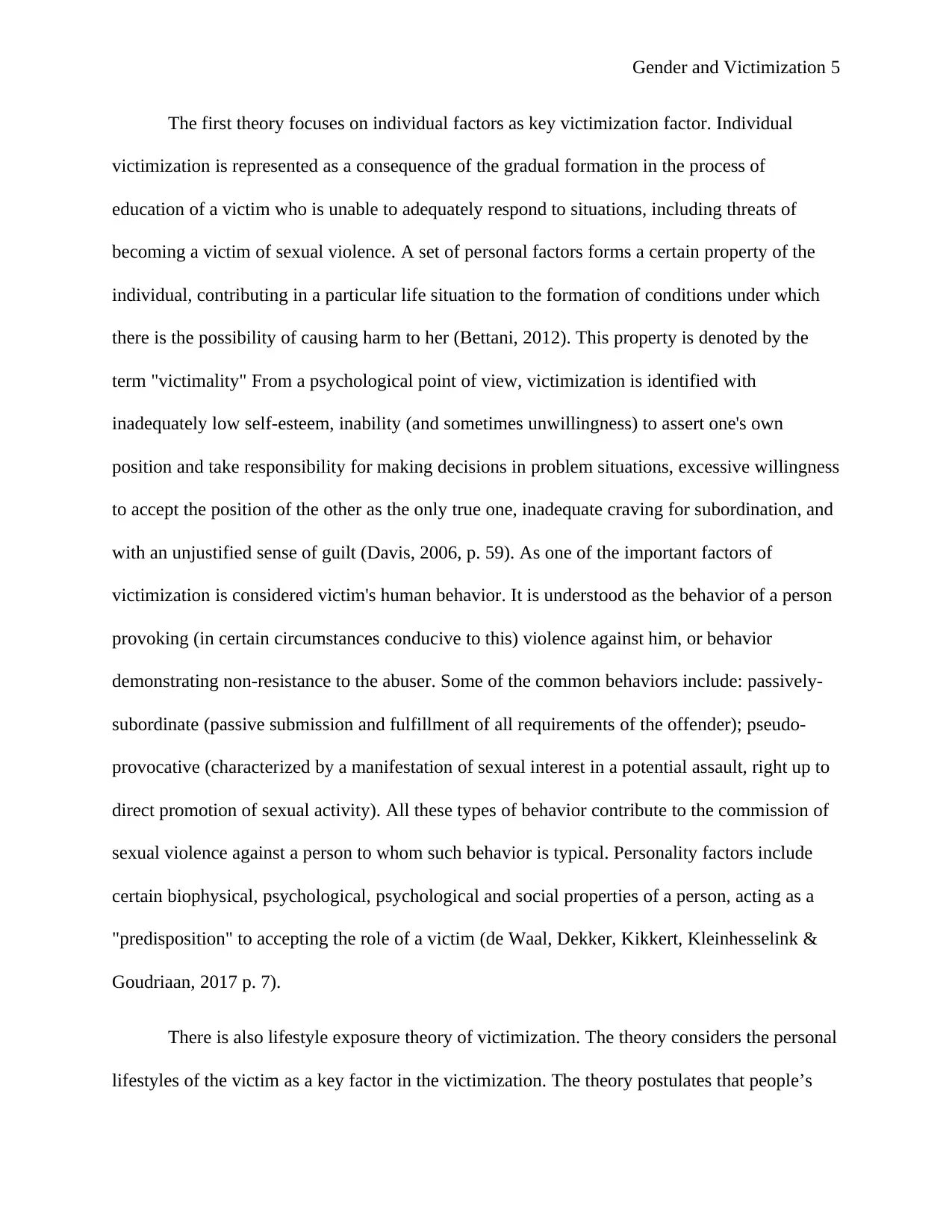
Gender and Victimization 5
The first theory focuses on individual factors as key victimization factor. Individual
victimization is represented as a consequence of the gradual formation in the process of
education of a victim who is unable to adequately respond to situations, including threats of
becoming a victim of sexual violence. A set of personal factors forms a certain property of the
individual, contributing in a particular life situation to the formation of conditions under which
there is the possibility of causing harm to her (Bettani, 2012). This property is denoted by the
term "victimality" From a psychological point of view, victimization is identified with
inadequately low self-esteem, inability (and sometimes unwillingness) to assert one's own
position and take responsibility for making decisions in problem situations, excessive willingness
to accept the position of the other as the only true one, inadequate craving for subordination, and
with an unjustified sense of guilt (Davis, 2006, p. 59). As one of the important factors of
victimization is considered victim's human behavior. It is understood as the behavior of a person
provoking (in certain circumstances conducive to this) violence against him, or behavior
demonstrating non-resistance to the abuser. Some of the common behaviors include: passively-
subordinate (passive submission and fulfillment of all requirements of the offender); pseudo-
provocative (characterized by a manifestation of sexual interest in a potential assault, right up to
direct promotion of sexual activity). All these types of behavior contribute to the commission of
sexual violence against a person to whom such behavior is typical. Personality factors include
certain biophysical, psychological, psychological and social properties of a person, acting as a
"predisposition" to accepting the role of a victim (de Waal, Dekker, Kikkert, Kleinhesselink &
Goudriaan, 2017 p. 7).
There is also lifestyle exposure theory of victimization. The theory considers the personal
lifestyles of the victim as a key factor in the victimization. The theory postulates that people’s
The first theory focuses on individual factors as key victimization factor. Individual
victimization is represented as a consequence of the gradual formation in the process of
education of a victim who is unable to adequately respond to situations, including threats of
becoming a victim of sexual violence. A set of personal factors forms a certain property of the
individual, contributing in a particular life situation to the formation of conditions under which
there is the possibility of causing harm to her (Bettani, 2012). This property is denoted by the
term "victimality" From a psychological point of view, victimization is identified with
inadequately low self-esteem, inability (and sometimes unwillingness) to assert one's own
position and take responsibility for making decisions in problem situations, excessive willingness
to accept the position of the other as the only true one, inadequate craving for subordination, and
with an unjustified sense of guilt (Davis, 2006, p. 59). As one of the important factors of
victimization is considered victim's human behavior. It is understood as the behavior of a person
provoking (in certain circumstances conducive to this) violence against him, or behavior
demonstrating non-resistance to the abuser. Some of the common behaviors include: passively-
subordinate (passive submission and fulfillment of all requirements of the offender); pseudo-
provocative (characterized by a manifestation of sexual interest in a potential assault, right up to
direct promotion of sexual activity). All these types of behavior contribute to the commission of
sexual violence against a person to whom such behavior is typical. Personality factors include
certain biophysical, psychological, psychological and social properties of a person, acting as a
"predisposition" to accepting the role of a victim (de Waal, Dekker, Kikkert, Kleinhesselink &
Goudriaan, 2017 p. 7).
There is also lifestyle exposure theory of victimization. The theory considers the personal
lifestyles of the victim as a key factor in the victimization. The theory postulates that people’s
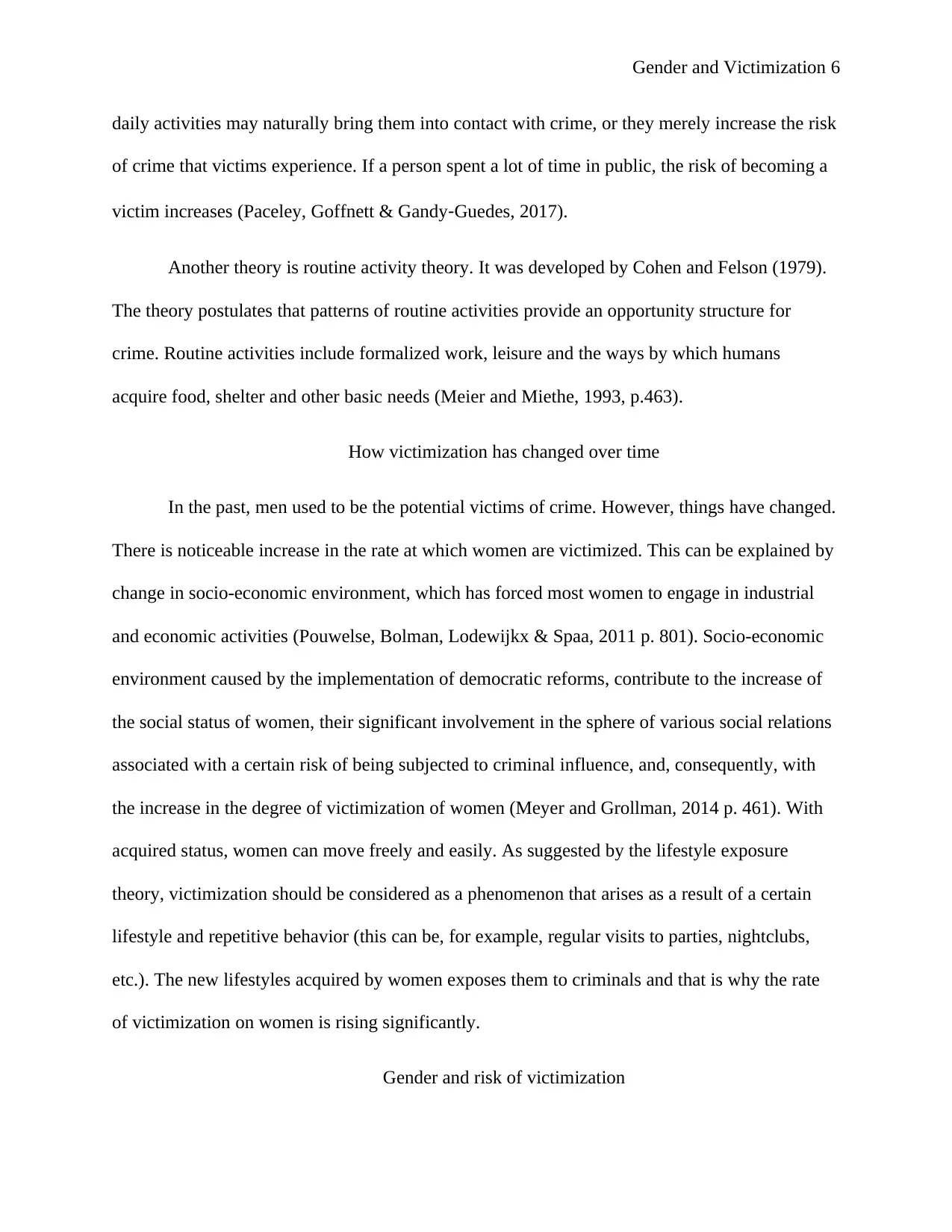
Gender and Victimization 6
daily activities may naturally bring them into contact with crime, or they merely increase the risk
of crime that victims experience. If a person spent a lot of time in public, the risk of becoming a
victim increases (Paceley, Goffnett & Gandy‐Guedes, 2017).
Another theory is routine activity theory. It was developed by Cohen and Felson (1979).
The theory postulates that patterns of routine activities provide an opportunity structure for
crime. Routine activities include formalized work, leisure and the ways by which humans
acquire food, shelter and other basic needs (Meier and Miethe, 1993, p.463).
How victimization has changed over time
In the past, men used to be the potential victims of crime. However, things have changed.
There is noticeable increase in the rate at which women are victimized. This can be explained by
change in socio-economic environment, which has forced most women to engage in industrial
and economic activities (Pouwelse, Bolman, Lodewijkx & Spaa, 2011 p. 801). Socio-economic
environment caused by the implementation of democratic reforms, contribute to the increase of
the social status of women, their significant involvement in the sphere of various social relations
associated with a certain risk of being subjected to criminal influence, and, consequently, with
the increase in the degree of victimization of women (Meyer and Grollman, 2014 p. 461). With
acquired status, women can move freely and easily. As suggested by the lifestyle exposure
theory, victimization should be considered as a phenomenon that arises as a result of a certain
lifestyle and repetitive behavior (this can be, for example, regular visits to parties, nightclubs,
etc.). The new lifestyles acquired by women exposes them to criminals and that is why the rate
of victimization on women is rising significantly.
Gender and risk of victimization
daily activities may naturally bring them into contact with crime, or they merely increase the risk
of crime that victims experience. If a person spent a lot of time in public, the risk of becoming a
victim increases (Paceley, Goffnett & Gandy‐Guedes, 2017).
Another theory is routine activity theory. It was developed by Cohen and Felson (1979).
The theory postulates that patterns of routine activities provide an opportunity structure for
crime. Routine activities include formalized work, leisure and the ways by which humans
acquire food, shelter and other basic needs (Meier and Miethe, 1993, p.463).
How victimization has changed over time
In the past, men used to be the potential victims of crime. However, things have changed.
There is noticeable increase in the rate at which women are victimized. This can be explained by
change in socio-economic environment, which has forced most women to engage in industrial
and economic activities (Pouwelse, Bolman, Lodewijkx & Spaa, 2011 p. 801). Socio-economic
environment caused by the implementation of democratic reforms, contribute to the increase of
the social status of women, their significant involvement in the sphere of various social relations
associated with a certain risk of being subjected to criminal influence, and, consequently, with
the increase in the degree of victimization of women (Meyer and Grollman, 2014 p. 461). With
acquired status, women can move freely and easily. As suggested by the lifestyle exposure
theory, victimization should be considered as a phenomenon that arises as a result of a certain
lifestyle and repetitive behavior (this can be, for example, regular visits to parties, nightclubs,
etc.). The new lifestyles acquired by women exposes them to criminals and that is why the rate
of victimization on women is rising significantly.
Gender and risk of victimization
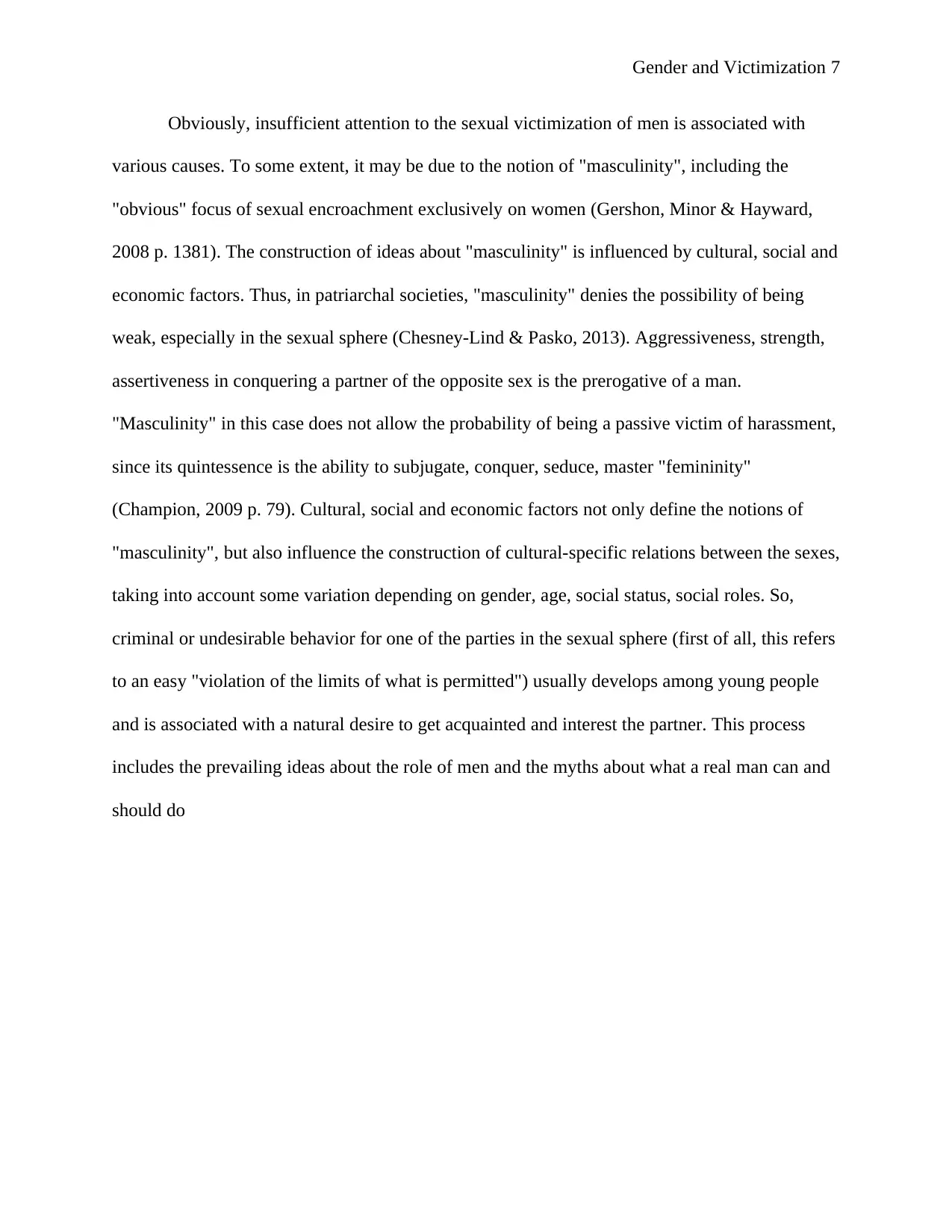
Gender and Victimization 7
Obviously, insufficient attention to the sexual victimization of men is associated with
various causes. To some extent, it may be due to the notion of "masculinity", including the
"obvious" focus of sexual encroachment exclusively on women (Gershon, Minor & Hayward,
2008 p. 1381). The construction of ideas about "masculinity" is influenced by cultural, social and
economic factors. Thus, in patriarchal societies, "masculinity" denies the possibility of being
weak, especially in the sexual sphere (Chesney-Lind & Pasko, 2013). Aggressiveness, strength,
assertiveness in conquering a partner of the opposite sex is the prerogative of a man.
"Masculinity" in this case does not allow the probability of being a passive victim of harassment,
since its quintessence is the ability to subjugate, conquer, seduce, master "femininity"
(Champion, 2009 p. 79). Cultural, social and economic factors not only define the notions of
"masculinity", but also influence the construction of cultural-specific relations between the sexes,
taking into account some variation depending on gender, age, social status, social roles. So,
criminal or undesirable behavior for one of the parties in the sexual sphere (first of all, this refers
to an easy "violation of the limits of what is permitted") usually develops among young people
and is associated with a natural desire to get acquainted and interest the partner. This process
includes the prevailing ideas about the role of men and the myths about what a real man can and
should do
Obviously, insufficient attention to the sexual victimization of men is associated with
various causes. To some extent, it may be due to the notion of "masculinity", including the
"obvious" focus of sexual encroachment exclusively on women (Gershon, Minor & Hayward,
2008 p. 1381). The construction of ideas about "masculinity" is influenced by cultural, social and
economic factors. Thus, in patriarchal societies, "masculinity" denies the possibility of being
weak, especially in the sexual sphere (Chesney-Lind & Pasko, 2013). Aggressiveness, strength,
assertiveness in conquering a partner of the opposite sex is the prerogative of a man.
"Masculinity" in this case does not allow the probability of being a passive victim of harassment,
since its quintessence is the ability to subjugate, conquer, seduce, master "femininity"
(Champion, 2009 p. 79). Cultural, social and economic factors not only define the notions of
"masculinity", but also influence the construction of cultural-specific relations between the sexes,
taking into account some variation depending on gender, age, social status, social roles. So,
criminal or undesirable behavior for one of the parties in the sexual sphere (first of all, this refers
to an easy "violation of the limits of what is permitted") usually develops among young people
and is associated with a natural desire to get acquainted and interest the partner. This process
includes the prevailing ideas about the role of men and the myths about what a real man can and
should do
Paraphrase This Document
Need a fresh take? Get an instant paraphrase of this document with our AI Paraphraser
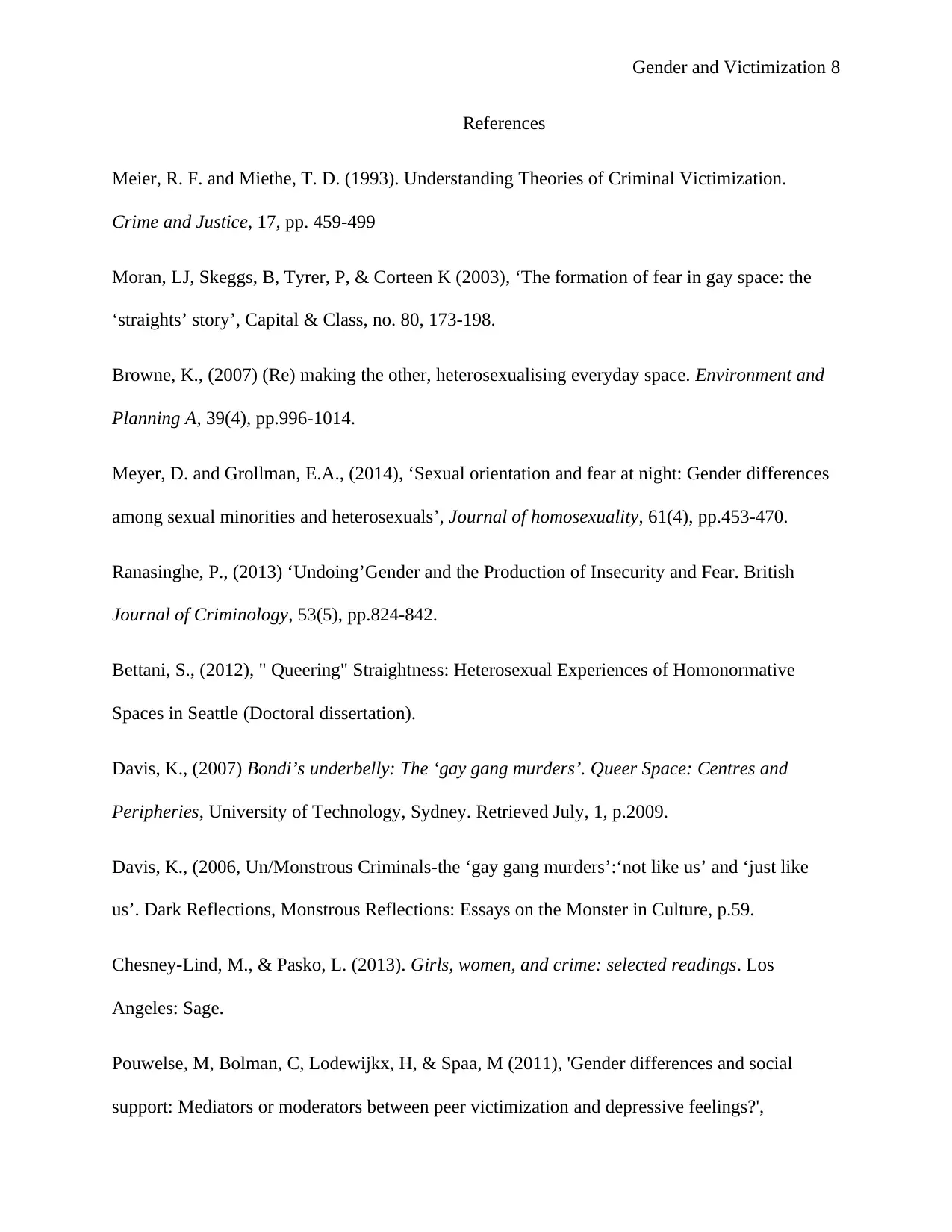
Gender and Victimization 8
References
Meier, R. F. and Miethe, T. D. (1993). Understanding Theories of Criminal Victimization.
Crime and Justice, 17, pp. 459-499
Moran, LJ, Skeggs, B, Tyrer, P, & Corteen K (2003), ‘The formation of fear in gay space: the
‘straights’ story’, Capital & Class, no. 80, 173-198.
Browne, K., (2007) (Re) making the other, heterosexualising everyday space. Environment and
Planning A, 39(4), pp.996-1014.
Meyer, D. and Grollman, E.A., (2014), ‘Sexual orientation and fear at night: Gender differences
among sexual minorities and heterosexuals’, Journal of homosexuality, 61(4), pp.453-470.
Ranasinghe, P., (2013) ‘Undoing’Gender and the Production of Insecurity and Fear. British
Journal of Criminology, 53(5), pp.824-842.
Bettani, S., (2012), " Queering" Straightness: Heterosexual Experiences of Homonormative
Spaces in Seattle (Doctoral dissertation).
Davis, K., (2007) Bondi’s underbelly: The ‘gay gang murders’. Queer Space: Centres and
Peripheries, University of Technology, Sydney. Retrieved July, 1, p.2009.
Davis, K., (2006, Un/Monstrous Criminals-the ‘gay gang murders’:‘not like us’ and ‘just like
us’. Dark Reflections, Monstrous Reflections: Essays on the Monster in Culture, p.59.
Chesney-Lind, M., & Pasko, L. (2013). Girls, women, and crime: selected readings. Los
Angeles: Sage.
Pouwelse, M, Bolman, C, Lodewijkx, H, & Spaa, M (2011), 'Gender differences and social
support: Mediators or moderators between peer victimization and depressive feelings?',
References
Meier, R. F. and Miethe, T. D. (1993). Understanding Theories of Criminal Victimization.
Crime and Justice, 17, pp. 459-499
Moran, LJ, Skeggs, B, Tyrer, P, & Corteen K (2003), ‘The formation of fear in gay space: the
‘straights’ story’, Capital & Class, no. 80, 173-198.
Browne, K., (2007) (Re) making the other, heterosexualising everyday space. Environment and
Planning A, 39(4), pp.996-1014.
Meyer, D. and Grollman, E.A., (2014), ‘Sexual orientation and fear at night: Gender differences
among sexual minorities and heterosexuals’, Journal of homosexuality, 61(4), pp.453-470.
Ranasinghe, P., (2013) ‘Undoing’Gender and the Production of Insecurity and Fear. British
Journal of Criminology, 53(5), pp.824-842.
Bettani, S., (2012), " Queering" Straightness: Heterosexual Experiences of Homonormative
Spaces in Seattle (Doctoral dissertation).
Davis, K., (2007) Bondi’s underbelly: The ‘gay gang murders’. Queer Space: Centres and
Peripheries, University of Technology, Sydney. Retrieved July, 1, p.2009.
Davis, K., (2006, Un/Monstrous Criminals-the ‘gay gang murders’:‘not like us’ and ‘just like
us’. Dark Reflections, Monstrous Reflections: Essays on the Monster in Culture, p.59.
Chesney-Lind, M., & Pasko, L. (2013). Girls, women, and crime: selected readings. Los
Angeles: Sage.
Pouwelse, M, Bolman, C, Lodewijkx, H, & Spaa, M (2011), 'Gender differences and social
support: Mediators or moderators between peer victimization and depressive feelings?',
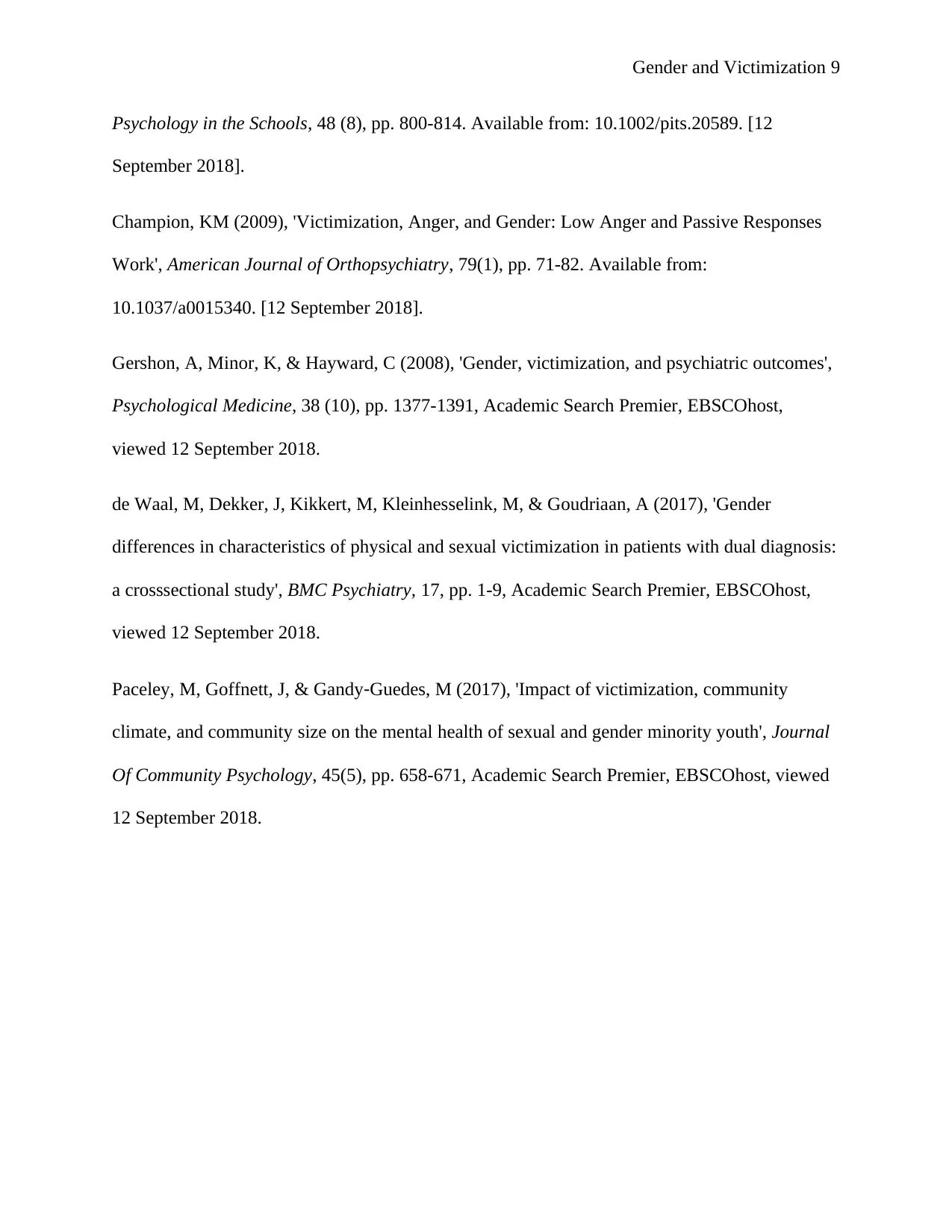
Gender and Victimization 9
Psychology in the Schools, 48 (8), pp. 800-814. Available from: 10.1002/pits.20589. [12
September 2018].
Champion, KM (2009), 'Victimization, Anger, and Gender: Low Anger and Passive Responses
Work', American Journal of Orthopsychiatry, 79(1), pp. 71-82. Available from:
10.1037/a0015340. [12 September 2018].
Gershon, A, Minor, K, & Hayward, C (2008), 'Gender, victimization, and psychiatric outcomes',
Psychological Medicine, 38 (10), pp. 1377-1391, Academic Search Premier, EBSCOhost,
viewed 12 September 2018.
de Waal, M, Dekker, J, Kikkert, M, Kleinhesselink, M, & Goudriaan, A (2017), 'Gender
differences in characteristics of physical and sexual victimization in patients with dual diagnosis:
a crosssectional study', BMC Psychiatry, 17, pp. 1-9, Academic Search Premier, EBSCOhost,
viewed 12 September 2018.
Paceley, M, Goffnett, J, & Gandy‐Guedes, M (2017), 'Impact of victimization, community
climate, and community size on the mental health of sexual and gender minority youth', Journal
Of Community Psychology, 45(5), pp. 658-671, Academic Search Premier, EBSCOhost, viewed
12 September 2018.
Psychology in the Schools, 48 (8), pp. 800-814. Available from: 10.1002/pits.20589. [12
September 2018].
Champion, KM (2009), 'Victimization, Anger, and Gender: Low Anger and Passive Responses
Work', American Journal of Orthopsychiatry, 79(1), pp. 71-82. Available from:
10.1037/a0015340. [12 September 2018].
Gershon, A, Minor, K, & Hayward, C (2008), 'Gender, victimization, and psychiatric outcomes',
Psychological Medicine, 38 (10), pp. 1377-1391, Academic Search Premier, EBSCOhost,
viewed 12 September 2018.
de Waal, M, Dekker, J, Kikkert, M, Kleinhesselink, M, & Goudriaan, A (2017), 'Gender
differences in characteristics of physical and sexual victimization in patients with dual diagnosis:
a crosssectional study', BMC Psychiatry, 17, pp. 1-9, Academic Search Premier, EBSCOhost,
viewed 12 September 2018.
Paceley, M, Goffnett, J, & Gandy‐Guedes, M (2017), 'Impact of victimization, community
climate, and community size on the mental health of sexual and gender minority youth', Journal
Of Community Psychology, 45(5), pp. 658-671, Academic Search Premier, EBSCOhost, viewed
12 September 2018.
1 out of 9
Related Documents
Your All-in-One AI-Powered Toolkit for Academic Success.
+13062052269
info@desklib.com
Available 24*7 on WhatsApp / Email
![[object Object]](/_next/static/media/star-bottom.7253800d.svg)
Unlock your academic potential
© 2024 | Zucol Services PVT LTD | All rights reserved.




